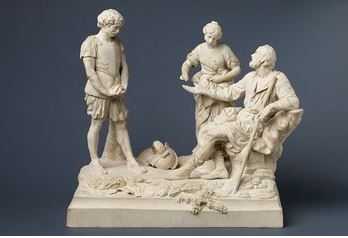|
This performing animal group is almost always found as you see it here, with one notable exception. I have recorded the very same cast of characters assembled on two bases, as you see below. I know of only this example of this pair. Like the all-on-one-base group shown above, it can be attributed to the Patriotic Group pot bank. Judging from the varied bocages found on the performing animal troupes that I have recorded, several pot banks had a go at making this model. The little figures are largely the same, so I think the molds for them did the rounds in the Staffordshire Potteries. Particularly noteworthy is this large "Sherratt" spill vase, with the very same cast of characters. The same small figures are found within a rare arbor --see Staffordshire Figures 1780-1840 Volume 2 for the arbor group as well other assemblages with bocages. You cannot fail to be charmed by them. To my eye, original animals are a must, but other restoration is to be tolerated. And don't for one moment be taken in by the crude Asian copies that abound, but then, Dear Reader, I suspect you are far too discriminating to be that easily fooled!
0 Comments
Last week, I was blown away by an email from my friend and fellow collector, Bob Carde. It concerned this unique Staffordshire figure group in the Hunt Collection. The figure group has long been clouded in mystery. In the many decades that the Hunts have owned it, nobody has been able to identify the subject--including this so-called "expert!" But lo and behold, Bob has nailed it. He pointed me to the look-alike earthenware figure group below in the Victoria and Albert Museum. It is described as Belisarius receiving alms, made by the French pottery manufactory at Bellevue in the late eighteenth century. The pearlware group is made from slightly different molds than those used for the French group, but I suspect the English potter probably made his molds off the French group. This must have been a difficult and costly task, and it is hard to believe that he did not then make many figure groups from the molds. And yet the Hunt example is the only one known to have survived. So who was Belisarius? Briefly, he was one of the last great Roman generals, and he lived in the sixth century. According to legend that became popular in the Middle Ages, Emperor Justinian ordered his eyes put out. This left Belisarius a homeless beggar--as you see in the figure group. The veracity of the story is dubious, and some believe it to be apocryphal. However, the subject came into favor in art in the late 1700s, with artists seeing parallels between Justinian's repressive actions and contemporary rulers. I am enormously grateful to Bob for his superb detective work. Of course, I wish I had known the identity of this figure group before I published it in Holding the Past, but acquiring knowledge is, alas, a slow and painful process. Better late than never! Bob is an erudite, curious, and thoughtful collector who always generously shares his resources and his discoveries, and I am immensely appreciative. I feel like I have been given a great birthday gift,and I didn't have to age a year to get it!
|
Archives
February 2024
All material on this website is protected by copyright law. You may link to this site from your site, but please contact Myrna if you wish to reproduce any of this material elsewhere. |





















